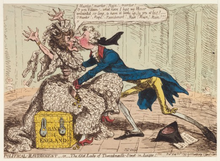Bank Restriction Act 1797
 From Wikipedia the free encyclopedia
From Wikipedia the free encyclopedia
| Act of Parliament | |
 | |
| Long title | An Act for confirming and continuing for a limited time, the restriction contained in the minute of council of the twenty-fifth of February one thousand seven hundred and ninety-seven, on payments of cash by the bank. |
|---|---|
| Citation | 37 Geo. 3. c. 45 |
| Dates | |
| Royal assent | 3 May 1797 |
| Expired | 2 December 1797 |
| Repealed | 21 August 1871 |
| Other legislation | |
| Repealed by | Statute Law Revision Act 1871 |
Status: Repealed | |
| Act of Parliament | |
 | |
| Long title | An Act to amend and continue, until one month after the conclusion of the present war, the provisions contained in an act, passed in the session of parliament of the thirty-sixth and thirty-seventh years of his present Majesty, chapter ninety-one, videlicet, on the twenty second of June one thousand seven hundred and ninety-seven, for the restriction on payments of cash by the bank. |
|---|---|
| Citation | 38 Geo. 3. c. 1 |
| Dates | |
| Royal assent | 30 November 1797 |
| Text of statute as originally enacted | |
The Bank Restriction Act 1797 (37 Geo. 3. c. 45) was an Act of the Parliament of Great Britain which removed the requirement for the Bank of England to convert banknotes into gold. The period lasted until 1821, when convertibility was restored. The period between these two dates is known as the Restriction period.
Reasons for restricting
[edit]An increasing number of people were trading their banknotes for gold. Due to the overprinting of banknotes, the Bank of England was losing its supply of gold, and due to the gold standard, the value of each banknote was diminishing.[1] The timing of the act, which had been under consideration for a few months owing to runs on banks in Newcastle-upon-Tyne, Sunderland, and Durham that had in turn requested monetary support from the Bank of England,[2] was the invasion of Britain on 22–24 February 1797 by French forces in Fishguard. When news of this event, now known as the Battle of Fishguard, became known in London, a much greater run on the Bank of England was feared, had a large number of holders of banknotes attempted to convert them into gold when bullion reserves were heavily reduced. However, because the total face value of the notes in circulation was almost exactly twice the actual gold reserves held (£10,865,050 of notes, compared to £5,322,010 in bullion),[3] this would have bankrupted the Bank, and Parliament decided to suspend these "specie payments" with immediate effect; this suspension was renewed annually until 1821.[4]
Reasons for overprinting
[edit]British banknotes were overprinted by the government of William Pitt the Younger after Britain declared war on revolutionary France in 1793.[5] The Bank Restriction Act released the government from the fear of mass redemption of such convertible banknotes, and by the end of the war in 1814 the banknotes in circulation had a face value of £28.4 million, yet were backed by only £2.2 million of gold. However, by 1821, and with radical economic policies instigated by Sir Robert Peel (the future Prime Minister, acting as Chairman of the Bullion Committee), this situation was reversed, and with £2,295,360 of notes in circulation being backed by £11,233,390 of bullion,[3] the British government resumed "convertibility" on 1 May 1821 (two years ahead of schedule).
In popular culture
[edit]
After the passing of the act, Richard Brinsley Sheridan publicly bemoaned the way in which the Bank of England had fallen under the influence of William Pitt the Younger by describing the institution as "An elderly lady in the City, of great credit and long standing who had unfortunately fallen into bad company". This in turn led to James Gillray’s famous cartoon entitled Political Ravishment; or the Old Lady of Threadneedle Street in Danger, which depicts Pitt seducing the Bank of England, personified as an old lady attired in £1 and £2 notes, for her fortune.[6] This cartoon is the origin of the Bank's nickname of "The Old Lady of Threadneedle Street", still in use today.
See also
[edit]Further reading
[edit]- Patrick K O'Brien, Nuno Palma, Danger to the Old Lady of Threadneedle Street? The Bank Restriction Act and the regime shift to paper money, 1797–1821, European Review of Economic History
References
[edit]- ^ "Bank Restriction Act of 1797". Investopedia. Retrieved 10 March 2007.
- ^ "Mark Crosby, "The Bank Restriction Act (1797) and Banknote Forgery" | BRANCH". Retrieved 14 October 2022.
- ^ a b "WAR FINANCE IN ENGLAND.; The Bank Restriction Act of 1797--Suspension of Specie Payments for Twenty-four Years--How to Prevent Depreciation of the Currency". The New York Times. 27 January 1862. ISSN 0362-4331. Retrieved 14 October 2022.
- ^ "The Bank of England Restriction. 1797-1821". The North American Review. 105 (217): 393–434. 1867. ISSN 0029-2397. JSTOR 25108102.
- ^ "England". University of Pennsylvania. Archived from the original on 11 February 2007. Retrieved 10 March 2007.
- ^ "Mark Crosby, "The Bank Restriction Act (1797) and Banknote Forgery" | BRANCH". Retrieved 14 October 2022.